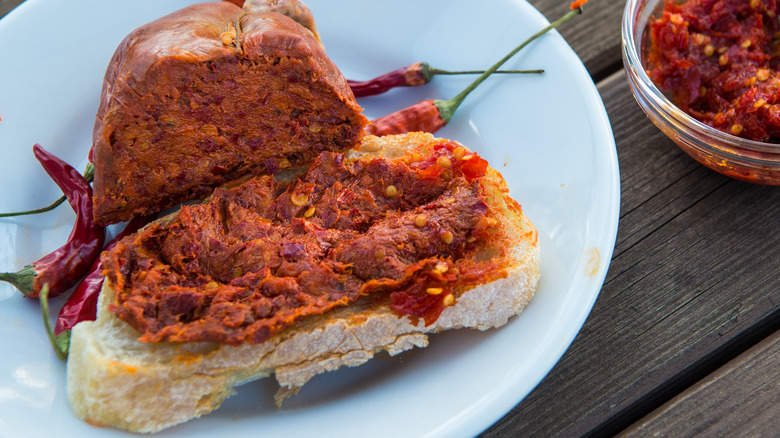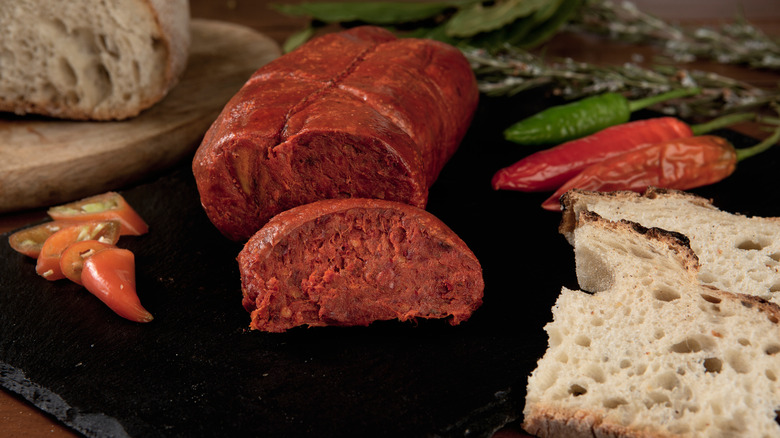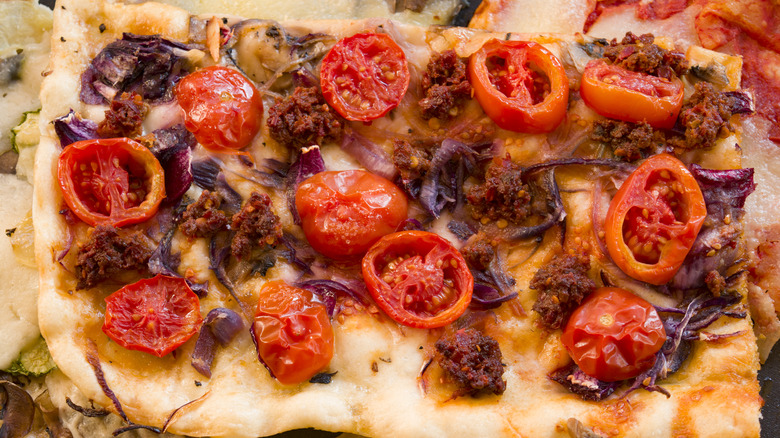The Easy Copycat 'Nduja For When You Can't Find The Real Thing
It wasn't so long ago that the spicy, spreadable Italian sausage known as 'nduja burst onto the culinary scene. Pronounced in-DOO-ya, it started out as a bit of a fine dining fad, and then suddenly it seemed like the pork chili paste was everywhere, from charcuterie boards to pizza, stuffed into pastas and popped onto burrata. One Italian food magazine even declared 2016 "The year of 'nduja," according to The Independent, which was followed by a bit of a backlash. It looks like 'nduja is going to be around for the long haul at this point, however, which is really nothing new to Italians, since they've been enjoying it for generations in southern Italy — it's just taken everyone else in the world this long to catch on.
Thanks to its popularity, 'nduja is a lot easier to find in specialty food stores these days than it was even ten years ago, but it's still not quite popular enough to show up in the cheese and sausage selections at a regular supermarket, especially if you don't live near a decent-sized city. If you can't wait until 'nduja reaches pesto or hummus status to stock up, and you don't live near an Eataly or a market that carries Italian imports, you can still scratch the itch for something like the spicy spread by mixing up your own batch at home using a few items that are easier to find at the store.
A little history
When you're trying to replicate any sort of recipe, step one is always figuring out what exactly it is you're trying to duplicate. So to make a clone, begin with dissecting 'nduja's ingredients and origins.
Originally from the Calabria region of Italy, which is the tip of "the boot," the "queen of salami" (per Bottega di Calabria) was originally a peasant food made out of pig scraps. The name is widely believed to come from the French word andouille, which in France is used to describe sausage made with tripe and pork entrails, and was probably introduced to Italy in the 19th century (per Bloomberg). The people of Calabria made the porky product their own by adding lots of heat with Calabrian chilis, which gives 'nduja its signature bright red color.
These days 'nduja is made out of fatty cuts like pork cheeks, lard, and belly rather than scraps, however, according to Bottega di Calabria. The meat is minced, mashed, and mixed up with tons of chili pepper, which acts as a preservative. The mix is then stuffed into a natural casing, lightly smoked, and cured for three to six months. Curing ferments the sausage in the casing, which is an anaerobic environment, and brings the pH of the sausage down to give it an acidic tang.
Nearly 'nduja
Real 'nduja is a closely held part of Calabrian culture, but it's not protected by any laws that dictate legal designation such as San Marzano tomatoes, so technically it's ok to make a version of it outside of Italy and call it 'nduja. So if you want to make a spicy, sausage-based spread at home that closely resembles the real thing, the Italian authorities won't be kicking down your door, or at the very least you won't be offending any of your Italian friends (unlike with pineapple pizza).
All you need to make a pretty passable substitute for 'nduja is a combination of fatty cured pork products — Genoa salami, prosciutto, speck or pancetta work great — and add some spicy peppers or Calabrian chili paste to punch up the heat and achieve the right color; try paprika, pickled Calabrian chilies, and fresh red Fresno pepper. A little dry buttermilk will also give it a bit of sourness without adding moisture, according to The New York Times.
Combine all of your ingredients in a food processor and pulse, using olive oil to thin things out and get a spreadable texture. Don't let the food processor run for too long so that you don't overwork the meat. When you get the right consistency, season to taste with salt and pepper, and it's ready to be slathered on a slice of bread, baked on top of pizza, or cooked up with some pasta for dinner.


